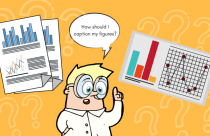Presenting Figures and Their Importance in Research Papers

The old adage that a picture tells a thousand words can be very true in research articles. Used correctly, figures provide efficient visual presentations of your qualitative or quantitative findings. Used incorrectly, figures and tables can be confusing or even misleading for the reader. It is, therefore, crucial to consider how this data will be presented in your articles carefully during the manuscript preparation process.
Using Figures in Articles
One useful approach to writing research articles is to list each of your key findings in a logical order. Then, create figures or tables illustrating the data that you intend to report. This, in turn, provides the skeletal content and structure of your Methods section, which should match the order in which the figures are provided. At this early stage, identifying the journal to which you will submit the article is important because each journal has specific formatting instructions relating to figures and tables, which can be found in the ‘Instructions to Authors’ section. These may be very detailed, such as those provided by the Journal of Clinical Investigation. If the formatting instructions are not very specific, consider using the following standard approaches.
Conciseness and Consistency
Depending on the journal guidelines, figures and tables are usually placed within the text or on separate pages after the end-list references. Always ensure that the legends and abbreviations have exactly the same format as that used in the text. Finally, ensure that every figure provides a clear and brief explanation of the results that have been obtained. Also, it may be necessary to provide important background information regarding the images that have been used as journals are employing tools and processes to detect data and image manipulation.
Using Figures or Tables
Table footnotes are usually provided below each table to explain the data provided within them such as the abbreviations and symbols that have been used. Similarly, for each figure a good caption, which should be as short as possible, is critical to help the reader understand the content that has been presented. Depending on the nature of the results that have been obtained, some types of information clearly need to be presented as images, whereas tables are helpful for providing detailed data analysis (for example, lists of target gene names, codes, and primer sequences). For any research paper, balancing the usage of figures or tables helps the reader understand the content easily and determine the relevance of your study for his research. For example, when presenting changes in the expression of a number of genes under various conditions, or temporal changes in soil bacteria levels at a range of locations, it is sensible to choose the form that best conveys your key message relating to the specific research finding. Often, the best way to make this decision is to create multiple alternative Figures and/or Tables and consult your co-authors or colleagues to determine which of them fit the requirements of the article. It is always good to effectively convey information through figures and tables as readers and journals prefer having articles that are visually appealing.







